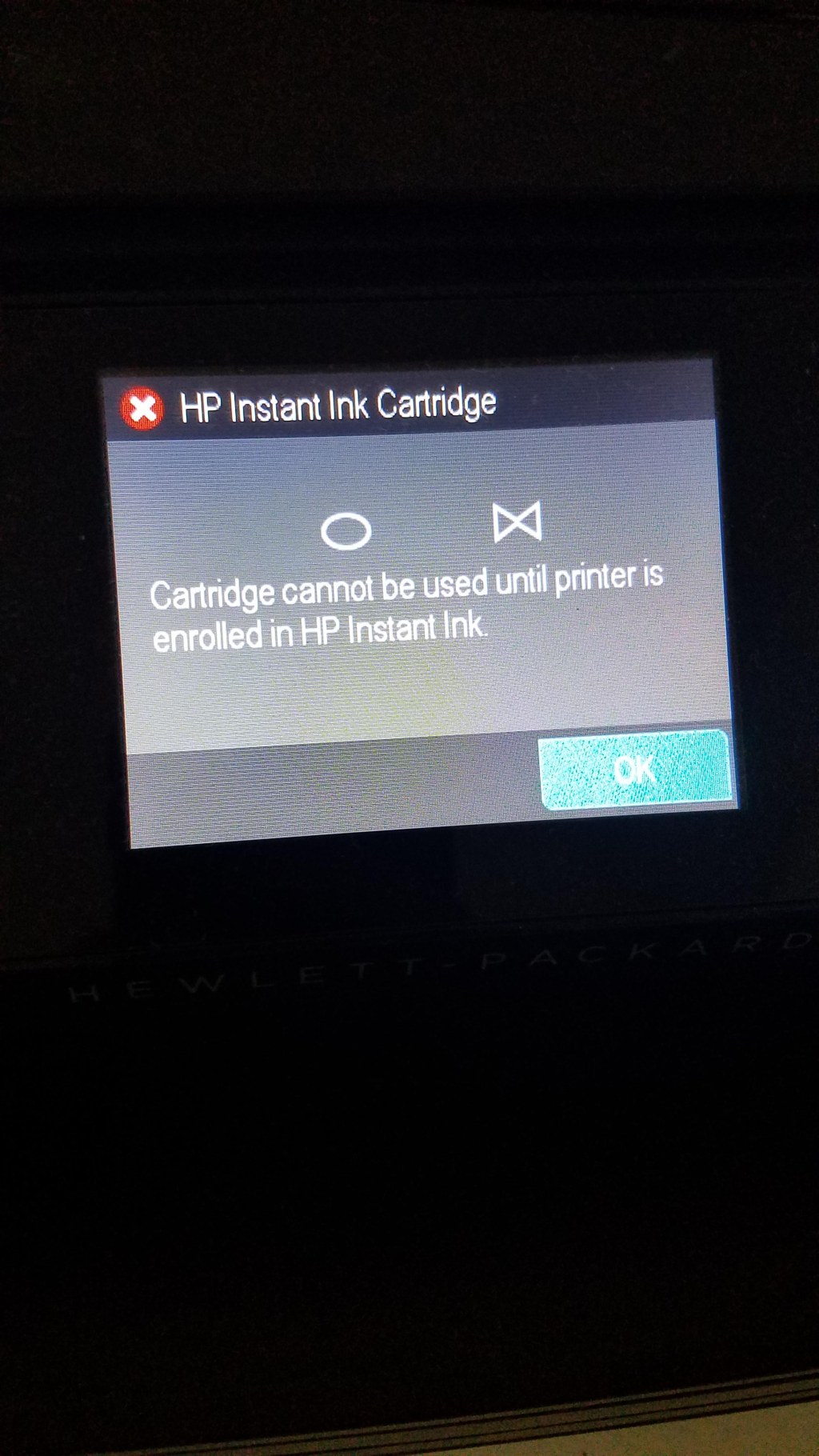Unleashing The Power Of Printer Ink DRM: Simplifying, Enhancing, And Protecting Your Prints!
Printer Ink DRM: The Impact of Digital Rights Management on the Printing Industry
Table of Contents
Introduction
What is Printer Ink DRM?
Who Implements Printer Ink DRM?
When Did Printer Ink DRM Emerge?
Where is Printer Ink DRM Used?
Why is Printer Ink DRM Controversial?
How Does Printer Ink DRM Work?
Advantages and Disadvantages of Printer Ink DRM
Frequently Asked Questions
Conclusion
Final Remarks
2 Picture Gallery: Unleashing The Power Of Printer Ink DRM: Simplifying, Enhancing, And Protecting Your Prints!


Introduction
Hello Readers,

Image Source: redd.it
Welcome to our latest article where we delve into the world of printer ink DRM. In this digital age, the protection of intellectual property has become increasingly important, and the printing industry is no exception. Printer ink DRM, or Digital Rights Management, has emerged as a solution to combat counterfeiting and unauthorized printing. In this article, we will explore the intricacies of printer ink DRM, its impact on the industry, and the ongoing debates surrounding its implementation.
So, let’s dive in and uncover the fascinating world of printer ink DRM!
What is Printer Ink DRM?

Image Source: mobilesyrup.com
🖨️ Printer ink DRM, also known as Digital Rights Management, refers to the incorporation of technological measures in printer ink cartridges to prevent unauthorized use, refill, or reproduction. It aims to protect intellectual property rights, combat counterfeiting, and regulate the usage of printer ink.
🔒 Printer ink DRM employs various mechanisms, such as embedded chips, encryption, and authentication protocols, to establish a secure connection between the printer and the ink cartridge. This ensures that only genuine ink cartridges are recognized and accepted by the printer.
🔏 The primary goal of printer ink DRM is to control the supply chain, prevent piracy, and maintain quality standards in the printing industry.
Who Implements Printer Ink DRM?
🏭 Printer ink DRM is implemented by printer manufacturers and ink cartridge suppliers. Companies like HP, Epson, Canon, and Brother have developed proprietary DRM systems to safeguard their products and protect their revenue streams.
🔧 Additionally, third-party companies specializing in printer ink refills and compatible cartridges also play a role in the printer ink DRM landscape. Some of these companies develop workarounds or alternative solutions to bypass DRM restrictions, offering consumers more affordable options.
When Did Printer Ink DRM Emerge?
📅 Printer ink DRM started to gain traction in the early 2000s as counterfeiting and unauthorized ink refills became prevalent. Printer manufacturers recognized the need to protect their intellectual property and revenue, leading to the development and implementation of printer ink DRM systems.
⌛ Since then, printer ink DRM has evolved, with advancements in technology allowing for more sophisticated measures to be employed. However, its implementation has faced backlash from consumers and industry experts, leading to ongoing debates around its effectiveness and ethical implications.
Where is Printer Ink DRM Used?
🌍 Printer ink DRM is used worldwide, across various industries and sectors that heavily rely on printing. This includes home users, small businesses, corporate environments, educational institutions, and governmental organizations.
🖨️ Printer manufacturers, ink cartridge suppliers, and compatible cartridge companies implement DRM systems in their products on a global scale, aiming to regulate the usage of printer ink and protect their intellectual property.
Why is Printer Ink DRM Controversial?
❓ Printer ink DRM has sparked controversy due to several factors. Critics argue that DRM systems limit consumer choice, restrict competition, and inflate the costs of printer ink. They claim that DRM can create a monopoly-like situation, where consumers are forced to purchase expensive, manufacturer-approved ink cartridges instead of more affordable alternatives.
❓ Additionally, printer ink DRM has been criticized for its impact on the environment. Some DRM systems render ink cartridges unusable after a certain number of prints or expiration date, contributing to electronic waste.
❓ Moreover, the effectiveness of printer ink DRM in preventing counterfeiting and unauthorized refills has been questioned. Despite the implementation of DRM, counterfeit ink cartridges and refill options still exist, rendering the effectiveness of DRM systems debatable.
How Does Printer Ink DRM Work?
🔧 Printer ink DRM works by incorporating various technological measures into ink cartridges and printers. These measures include embedded chips, encryption algorithms, and authentication protocols.
🔒 When a genuine ink cartridge is inserted into a printer, the embedded chip communicates with the printer’s firmware, verifying its authenticity and compatibility. If the cartridge is recognized as genuine, the printer allows the printing process to proceed. However, if an unauthorized or counterfeit cartridge is detected, the printer may display an error message or refuse to print.
🔏 Printer ink DRM systems also utilize encryption to prevent unauthorized access to the firmware and ink cartridge data. This ensures that only authorized parties can develop compatible ink cartridges and maintain the integrity of the DRM system.
🖨️ Overall, printer ink DRM aims to create a secure ecosystem where only authorized ink cartridges can be used, protecting intellectual property rights and maintaining quality standards.
Advantages and Disadvantages of Printer Ink DRM
Advantages:
1️⃣ Enhanced Intellectual Property Protection: Printer ink DRM systems help protect the intellectual property of printer manufacturers and ink cartridge suppliers, preventing counterfeiting and unauthorized reproduction.
2️⃣ Quality Control: By regulating the usage of printer ink, DRM systems ensure that customers receive high-quality prints, maintaining the reputation of the printing industry.
3️⃣ Revenue Protection: DRM helps manufacturers generate revenue by ensuring that genuine ink cartridges are used, discouraging consumers from opting for cheaper, unauthorized alternatives.
4️⃣ Security: The use of encryption and authentication protocols in DRM systems adds an extra layer of security, reducing the risk of printer ink fraud.
5️⃣ Innovation Incentives: Printer ink DRM encourages innovation in the development of new ink cartridge technologies, as manufacturers strive to stay ahead of counterfeiters and bypassing attempts.
Disadvantages:
1️⃣ Limited Consumer Choice: DRM systems can limit consumer options by restricting the use of compatible or third-party ink cartridges, potentially inflating ink costs.
2️⃣ Environmental Impact: Some DRM systems render ink cartridges unusable after a certain number of prints or expiration date, contributing to electronic waste.
3️⃣ Ethical Concerns: The implementation of DRM can be seen as a way for manufacturers to control and monopolize the market, limiting competition and potentially exploiting consumers.
4️⃣ Effectiveness Debate: Despite the implementation of DRM, counterfeit ink cartridges and unauthorized refills still exist, raising questions about the true effectiveness of DRM systems.
5️⃣ Cost Considerations: DRM systems may increase the cost of ink cartridges due to the additional technology and measures involved in their production, potentially impacting consumers’ printing expenses.
Frequently Asked Questions
1. Is printer ink DRM compatible with all printers?
🖨️ No, printer ink DRM systems are proprietary and specific to each printer manufacturer. Ink cartridges with DRM features are designed to work only with printers from the same manufacturer or those compatible with their DRM protocols.
2. Can printer ink DRM be bypassed?
🔓 While there are workarounds and alternative solutions available, bypassing printer ink DRM can be challenging. Manufacturers continuously update their DRM systems to prevent unauthorized access and reproduction.
3. Do printer ink DRM systems affect print quality?
🖼️ Printer ink DRM systems are designed to maintain print quality by ensuring the usage of genuine ink cartridges. Counterfeit or low-quality ink cartridges may compromise print quality and reliability.
4. Are there any legal implications associated with bypassing printer ink DRM?
⚖️ Bypassing printer ink DRM systems may infringe upon intellectual property rights and violate laws related to copyright and unauthorized reproduction. The legal implications vary depending on the jurisdiction and specific circumstances.
5. Can third-party ink cartridges work without printer ink DRM?
🔧 Yes, third-party ink cartridges can work without printer ink DRM. Some manufacturers offer compatible cartridges without DRM features, providing consumers with alternatives to expensive genuine ink cartridges.
Conclusion
In conclusion, printer ink DRM has become an integral part of the printing industry, aiming to protect intellectual property, combat counterfeiting, and regulate ink usage. While it offers advantages such as enhanced IP protection and quality control, printer ink DRM has faced criticism for limiting consumer choice, contributing to electronic waste, and raising ethical concerns.
As technology continues to advance, the debate surrounding printer ink DRM and its effectiveness will persist. It is essential for stakeholders, including manufacturers, consumers, and regulators, to find a balance between intellectual property protection and consumer rights.
Final Remarks
📝 Printer ink DRM represents a complex landscape with various stakeholders and considerations. This article provides an overview of the topic and highlights key points surrounding printer ink DRM. It is crucial for readers to conduct further research and stay informed about the latest developments and debates in the printing industry.
Remember, knowledge is power, and understanding printer ink DRM will empower you to make informed decisions regarding your printing needs.
This post topic: Printer Ink
